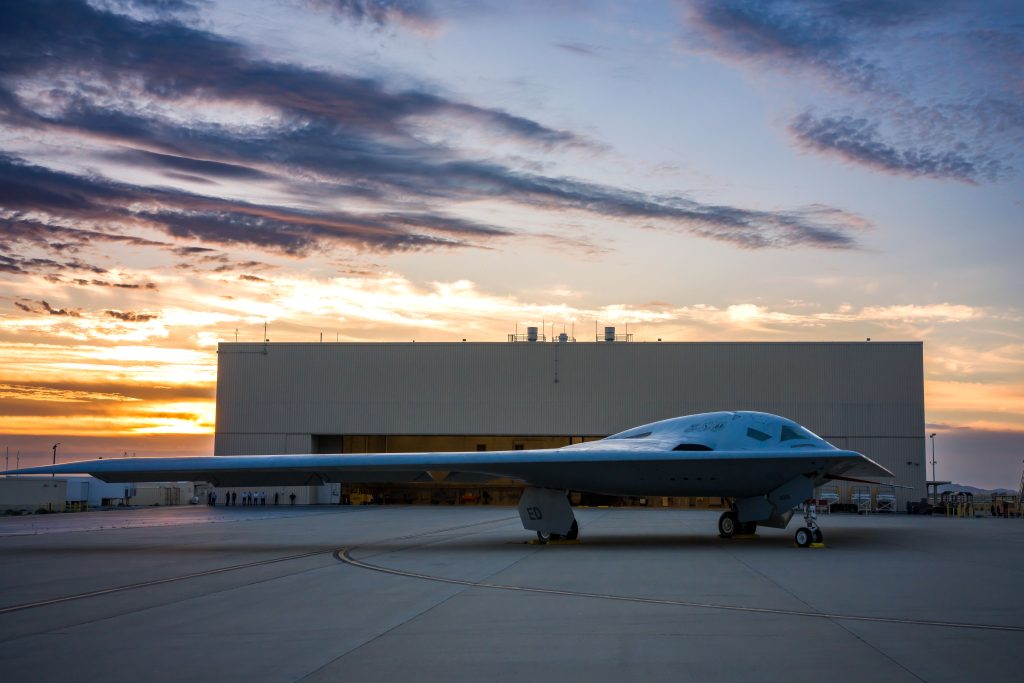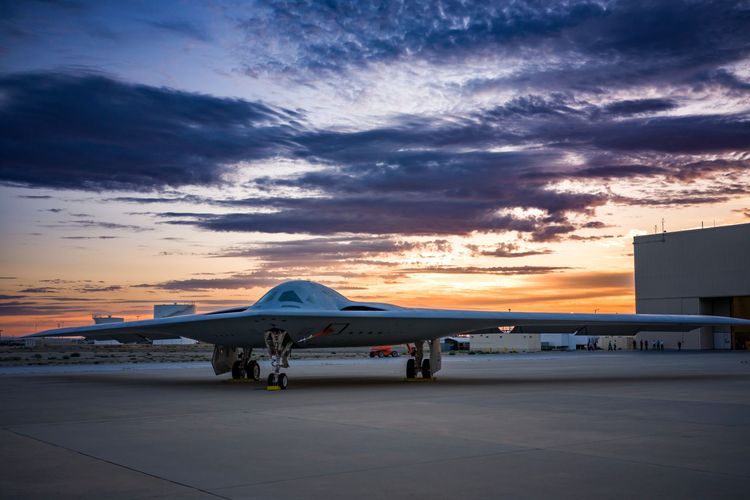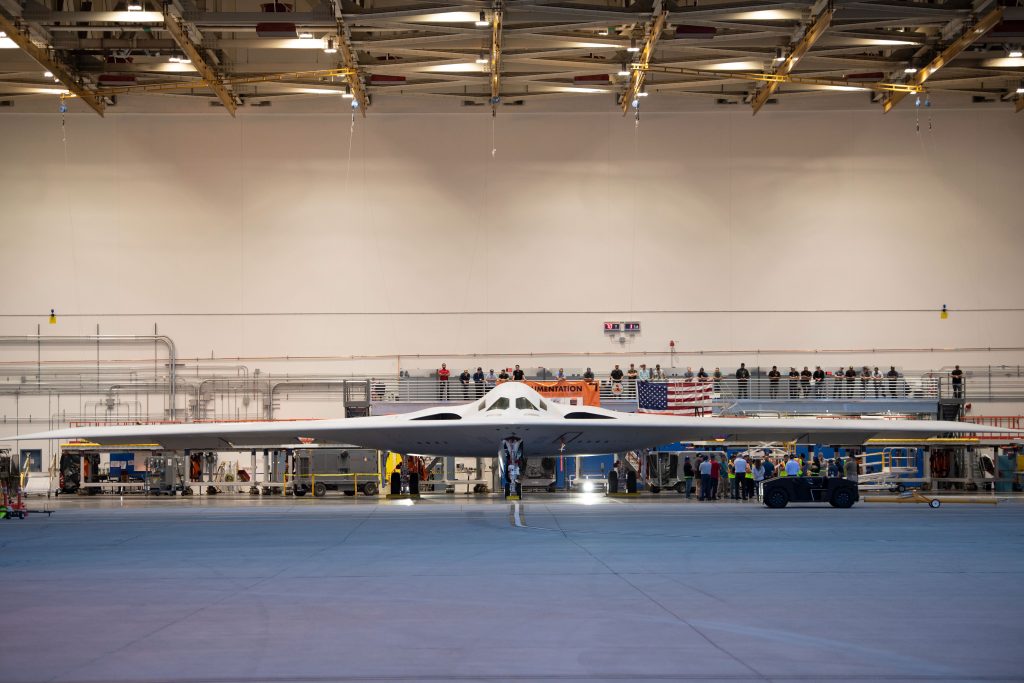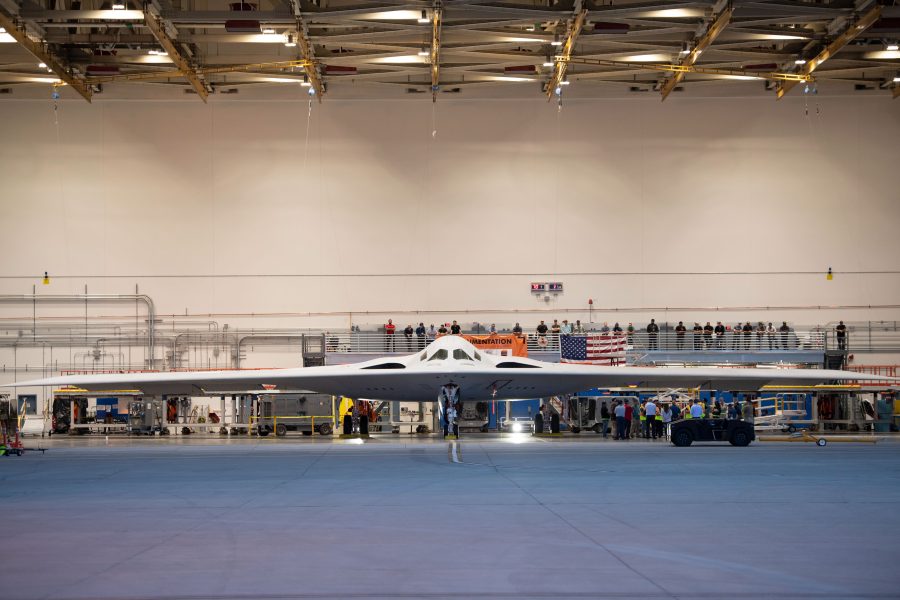Air Force Chief of Staff Gen. Charles Q. Brown Jr. and contractor Northrop Grumman both unveiled new imagery of the secretive B-21 Raider, the first glimpse of the stealthy bomber in months.
Two Air Force images, released during Brown’s keynote address at AFA’s Air, Space & Cyber Conference and dated July 31, showcase the bomber at Northrop Grumman’s Palmdale, Calif., facility. Notably, one shows the B-21 outdoors, a rare sighting of the aircraft outside the hangar.
Separately, Air Force Global Strike Command boss Gen. Thomas A. Bussiere announced Sept. 12 that the B-21 has begun engine runs as part of its ground testing program. Northrop Grumman subsequently confirmed the news and released another picture of the aircraft.
The most prominent new feature shown in the new images is an air data probe mounted on the front of the aircraft below the nose; a test item which will not be a feature of operational aircraft. The probe is angled downwards, suggesting the airplane may fly with a slight pitch-up attitude.

The images also emphasize how narrow the air intakes on the aircraft are—a marked contrast to the Air Force’s other stealth bomber, the B-2 Spirit—as well as the B-21’s simpler landing gear doors. The photos also appear to show the B-21’s flight control surfaces for the first time, seemingly three per side of the flying wing aircraft, and they seem larger than those on the B-2.
The outdoor image of the B-2 also reveals a serrated indentation on the top of the airframe behind the cockpit. The feature may be part of the air refueling receptacle system, which is in a similar position on the on the B-2.
The side windows of the B-21 seem smaller, wider and lower than was suggested in earlier artist’s concepts. A dark band sloping up onto the fuselage from the tail could be an extension of an infrared suppression system similar to that on the B-2, which uses space shuttle-tile-like materials to trap and disperse heat.
Air data sensors like those on the B-2 are prominent on the front of the aircraft in the hangar image. Black bands prominent beneath the windscreen could be air data sensors, a de-icing feature, or both.
Using ground crew in the hangar photo as a gauge, the aircraft appears to have a wingspan of approximately 135-155 feet, versus 172 feet for the B-2.

The Air Force rolled out the B-21, its first new bomber in more than three decades, in December 2022 at Northrop’s plant in Palmdale. The flashy ceremony, attended by Pentagon dignitaries, industry officials, and media, showcased some new features on what Northrop is dubbing the world’s first “sixth-generation” aircraft but also kept the general public at a distance from the secretive plane, whose full capabilities are still classified.
Then in March, the service released two more images of the B-21. Since then, however, there has been no sight of the bomber emerging from the hangar, either for ground or flight tests.
Northrop did announce in July that the bomber accomplished its first “power on” test in recent months, moving it another step closer to a first flight that is still scheduled to take place before the end of 2023.
No firm timeline has been set for that first flight, and in its most recent release, Northrop emphasized that it would be a “a data driven event.”
In his speech, Brown highlighted the B-21 as “a perfect example of successful design implementation, of operators and acquisition professionals working together to deliver capability to the warfighter. Just as importantly, developing the maintenance processes to ensure aircraft availability.”
“Air Force Global Strike Command has Airmen working to do that right now,” Brown added. “Airmen like Staff Sgt. Ashley Ross, ensuring the capability we need is supportable and maintainable Day One.”
Air Force officials have said the B-21 incorporates advancements in low-observance maintenance, typically an involved and difficult process, making the aircraft easier to repair and maintain.

In his own keynote speech Sept. 11, Air Force Materiel Command boss Gen. Duke Z. Richardson also highlighted the work of maintainers on the B-21.
“Transitioning from developing, acquiring, and testing to maintenance, our Air Force Sustainment Center steps in to provide essential logistic support,” Richardson said, before introducing a video of maintainers sharing their “real-world, wrench-turning stories.”
“We have been involved with the program since pre-source selection,” said Lauren Hazen, squadron director of the 556th Software Maintenance Group. “We actually had multiple technical experts working with the Rapid Capabilities Office to be part of that process, to really talk about lessons learned we’ve had on previous programs and to help develop plans to make sure we had a good process for the future.”


